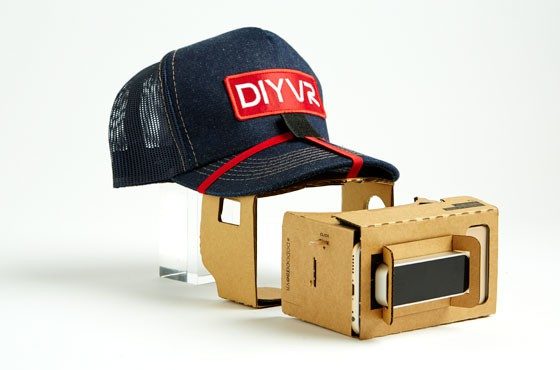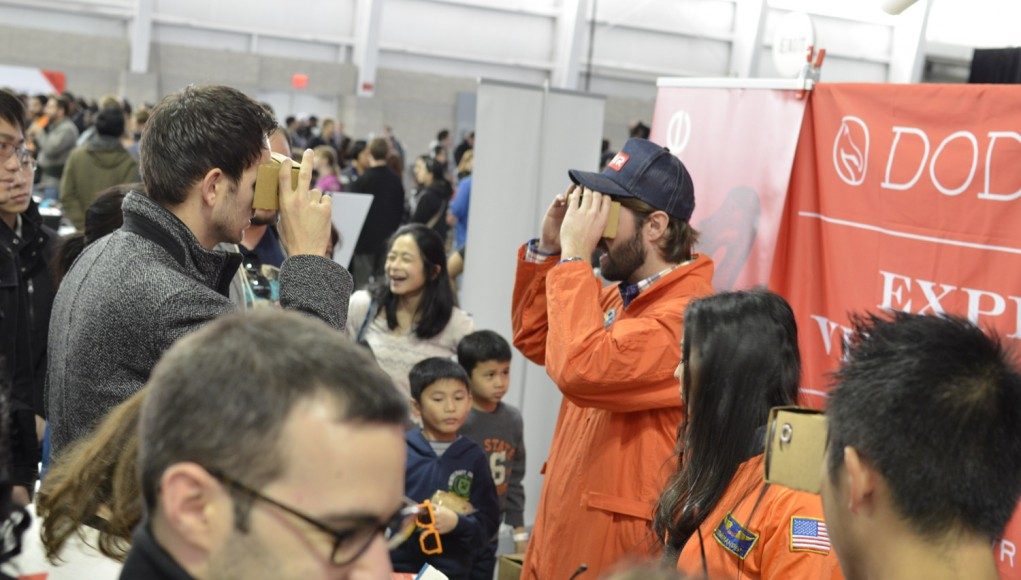Kickstarting a “DIY Virtual Reality Open Source Future”

Now the company is taking its next step into the world of VR with a Kickstarter campaign for a new version of Cardboard that its calling the DC-1 (Developer Cardboard Toolkit), which has both the magnetic ring input of the original Cardboard and the capacitive input from DODOcase’s v1.2 model. There’s also a Leap Motion mount and a rather hilarious add-on to turn any baseball cap into a Cardboard mount.
DODOcase DIY VR Open Source Future Kickstarter
The campaign, which aims to raise $25,000, is for more than just the DC-1 though. In the company’s own words:
What is DIYVR?
- Open, web-based software development tools for Virtual Reality.
- Accessible and adaptable Cardboard Smartphone VR toolkits that convert your smartphone into your very own Virtual Reality viewer
We’ve partnered with Virtual Reality pioneer, author, and developer extraordinaire Tony Parisi and his organization Third Eye to add VR support to the open source GLAM software. The proceeds from this campaign will help create software tools that will streamline web-based VR development.
Virtual Reality is the next new media platform, but its arrival has been hamstrung by expensive hardware and proprietary software. With your help, we can blow this industry wide open and accelerate its arrival by years. You can help any web developer be a Virtual Reality developer.
We’ll reward you generously with some fun perks, but the real reward will be all the awesome Virtual Reality games, apps and experiences to come!
DODOcase has also laid out a wealth of stretch goals, should the campaign exceed its aspirations:
$50,000 – Bootstrap of Mobile VR
Set of UI and interaction components to quickly build out DIYVR apps:
- Input: Gaze Tracking and Touch Handling
- Layout Managers: Clyinder, Sphere, Grid
- Heads-Up Display and Cockpit Controls
- Animations and Transitions
$150,000 – DIYVR Server, First Edition
Upload and share 3D models, photos, and videos from your fgavorite package, view in VR:
- 3D artists can upload models in FBX, OBJ, COLLADA, and other industry-standard formats exported by popular tools such as MAYA, 3ds Max, Blender, and Sketchup
- Easy upload of panoramic photos and videos
- Users browse gallery of latest, most popular and categorized using our standard DIYVR viewer
$250,000 – DIYVR Server, Full Publishing Platform
Build and host full apps and share with the world with no download:
- In-browser development tool for easy app building
- Templates for fast envrionment creation
- Application hosting service a la Heroku
$500,000 – DIYVR II
Everything included above, and more:
- More features, more templates, more UI widgets, more service levels in the hosting platform
- More hardware input mechanisms
- Tell us what else you would like to see us add to GLAM in the comments
The notion of a “DIY Virtual Reality Open Source Future” does feel a bit nebulous; what they’re really talking about is building up the GLAM language with simple VR-specific functionality that anyone will be able to use to get started on VR web apps. GLAM already aims to be a simple markup language for 3D web content; from GLAMs FAQ:
Let’s say you want to create a cube with a texture map (image) on its surface. Using the WebGL API, that’s about 300 lines of code. (Really.) You have to create buffers, load textures, set states, write shaders, and finally make drawing calls. It’s a ton of work, and it’s in an alien language full of unfamiliar concepts. So, you turn to Three.js to make it easier. Now, in about forty lines of code, you have accomplished the same thing, and are working with high level, easy to understand graphics objects. Cool… but think about it: forty lines of JavaScript code to make a cube. And that cube doesn’t animate, you can’t use your mouse to rotate it, and you can’t change its appearance with a style sheet. Wouldn’t it be great if you could just say
<cube>
and a cube appears on the page? You bet it would.
DODOcase’s Kickstarter aims to support GLAM’s ease of use in the VR space as well. From the above example, it might be easy to draw a cube with GLAM, but how do you render two warped views for the left and right eye as required by VR? And how do you tap into a smartphone’s sensors to support headtracking view control in the browser? The goal of this Kickstarter is to make that stuff easy too, so every developer doesn’t have to write it from the ground up.
There’s a few similar projects also hoping to make VR web development easy. Google itself launched a series of VR-enabled Chrome experiments which you can see on an Android phone here (or learn a bit more on your desktop here). The VR team at Mozilla Research is also publishing open-source code for VR content on the web. There’s also VR.js, though it hasn’t been updated in some time.
See Also: Mozilla Research VR Launches Experimental Website Compatible with Oculus Rift
At the time of writing, DODOcase’s Kickstarter is less than $5,000 short of their $25,000 goal and the company says that backers can expect their Cardboard VR kits by Christmas. We’ve got no doubt that the Kickstarter will reach its goal, but what will be most interesting to see is how far it surpasses it.







